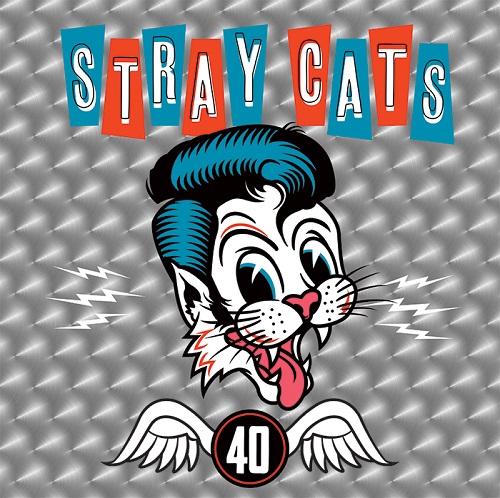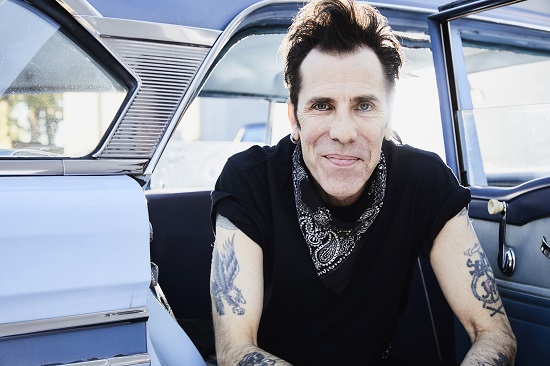Story by Shawn Perry
There is little argument that, in the midst of the new wave surge of the early 1980s, the Stray Cats single-handedly brought rockabilly back from its 1950s time capsule to the masses. Now, 40 years after their formation, the Long Island-based trio — guitarist and singer Brian Setzer, bassist Lee Rocker, and drummer Slim Jim Phantom — are back with their first new album in 26 years to reclaim their legacy.
During a phone chat about the aptly titled 40 set, I asked Phantom how, after several reunions over the years, the idea of making a new Stray Cats album came about. He said that after the group reunited at the Viva Las Vegas Rockabilly Weekend in 2018, they realized the demand for what they do is bigger than ever.
“It was really the flowering of something we thought of 40 years ago,” the drummer explained, a sense of measurable pride in his tone. “When we started doing this, we were really looking for someone who knew what we were talking about. And we loved the music. To see 40 years later, this giant subculture, this lifestyle. A lot of kids are into this. There was 20,000 plus kids and it looked like the opening ceremonies of the Olympics for rockabilly.”
The momentum from Las Vegas carried over to more Stray Cats shows over the summer of 2018. Soon after, according to Phantom, “Brian was getting in touch — ‘I’ve written some songs, I’ve had a burst of inspiration, is this something we can do?'”
That got all three Stray Cats talking. Demos were shared, the songs sounded great, everyone had ideas. The next thing you know, they were in a Nashville studio, ready to cut an album. In an effort to keeps things loose and natural, the band recorded the tracks mostly live, in formation and standing next to each other, as they would during a live performance.
They also enhanced their process and utilized the tools of the studio, employing old-school echo and inventive microphone placement to sound like Gene Vincent. “New technology or retro technology — whatever you want to call it,” Phantom laughed. “We were trying to sound like our favorite records.”

Another novel move for the Stray Cats was working with producer Peter Collins, known for producing records for Rush and Bon Jovi, on 40. Phantom says he wasn’t sure if the band even needed a producer, and that Collins functioned as more of a “guidance guy,” taking notes, suggesting small changes here and there, but basically letting the band do what they do. The hands-off approach Collins took made for a comfortable arrangement.
“Who’s going to really have the nerve to tell Brian what to play,” Phantom pointed out, adding that Collins and Setzer had worked together before. “Brian vouched for him. I didn’t really know him, but when I met him, it was immediate. I stay in touch with him now. We became friends through this record.”
As for the songs, I asked Phantom how the album’s feisty opener “Cat Fight (Over A Dog Like Me)” came together. “Brian wrote that one quickly and it was the first one on the demo. As soon as I heard it on the phone, we were inventing the parts.”
I mentioned a video for “Cry Danger” had just dropped, and Phantom recalled that the song came from a lick Setzer had written with guitarist Mike Campbell of the Heartbreakers. “I really like that one,” the drummer said. “It could be one that crosses over.” Indeed, the number has a deeper attack and broader verses, transcending the Stray Cats rootsy rockabilly sound.
“I Attract Trouble” and “Desperado” are two of the album’s highlights, the latter an instrumental cast in the mold of Link Wray and Dick Dale. Phantom heartily agreed. “Brian loves that stuff. Dick Dale was a pal. As a guitar player, he half-wrote the book for all the modern guitar players who want to play Rockabilly fused with surf music and the blues. That’s positively a tribute to Dick Dale.”
“Devil Train,” which ends 40, is more like a runaway train with some exceptional drumming from Phantom. “That was one of those ones: ‘Get it on the first take.’ Now, being a drummer is a little easier because you can loops things, and cut and paste in Pro Tools. The Stray Cats do it the old way, so when you do the song live like that, you got to play it right all the way through. That was one of those songs: ‘Don’t make a mistake at the end or we have to start the whole thing over again.’ That was one we were really concentrating on. When they said that one take was perfect, it was a little bit of a release for me. That’s a physical one.”

To promote 40, the Stray Cats will embark on an extensive two-month, 26-date tour of dates. It opens in Vitoria, Spain on June 21, followed by shows in England, France, the Netherlands, Germany, Finland and Sweden, then onto the States for a handful of appearances.
The Stray Cats initially broke in the UK, and their European fan-base is substantial. Are there any inherent differences between the European and American audiences?
“When we first started doing it, around ’81, I don’t think anyone in America knew the history of it (rockabilly) as well as the British,” Phantom recollected. “We’d be playing (in America), even as late as the mid 80s, a Gene Vincent song and they just thought it was a Stray Cats song. Where the British — they really do know the history of it. They know the Gene Vincent song, believe me. The music dictates your lifestyle in Europe. Certainly with the rockabilly. We just made that stronger. The British crowd, still to this day, might be a bit wilder.”
Before I let him go, I told Phantom I’d always been impressed with the Stray Cats’ style and presentation, which includes him standing up behind a bass drum, a snare drum and a cymbal or two. He was inspired to play standing up after seeing photographs of Gene Vincent and the Blue Caps, whose drummer Dickie Harrell can be seen standing behind a snare drum (though he rarely played standing up).
All three members of the Stray Cats were — and still are — very conscientious about their image. Playing rockabilly music obviously provided any number of ideas on which to base their act. “We were trying to base our whole lives on a photograph,” Phantom said.
Early on, the band decided to put the drums out front with Phantom standing up. Of course, once the Stray Cats take off during one of their performances, the drummer ascends to the top of his bass drum, banging away and never losing the tempo. It all makes for an exhilarating and entertaining aspect of the Stray Cats experience.
“We took a little bit of inspiration from the past and put our own, original spin on it,” the drummer told me. “You just can’t do something old. That’s always been our motto.”





















